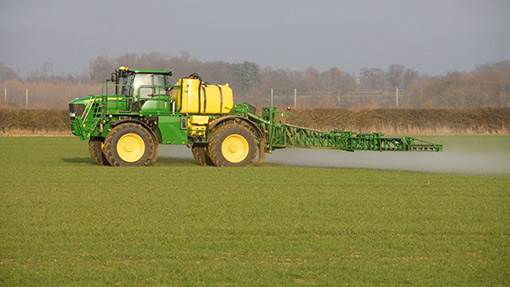New technology revives IPU herbicide

A British agrichemical company has used new technology to bring back herbicide isoproturon to battle grass and broad-leaved weeds in winter cereal crops.
It was announced that any products containing the molecule would be phased out in 2007, with their use in the field banned by 2009.
In its last days, the product was used at a rate of 1,500g of active/ha and it was deemed to pose unacceptable risk to aquatic organisms, such as daphnia and algae.
See also: Herbicide active chlorotoluron makes a comeback
Agform UK have now found a way to mitigate that risk by increasing the active ingredients efficacy, allowing it to be used at much lower concentrations, with an acceptable minimum effective dose.
The company’s managing director, John Misselbrook, explains that IPU in its previous form was an insoluble compound and decreasing its particle size has been key to getting it reapproved.
“Increasing the surface area of the particles, and therefore its solubility, means that more of the active ingredient will be taken up by the plant through leaves and roots.
“This allows the product to be more effective at lower rates as there is more active ingredient taken up by the target and less going into the soil and potentially, water,” he explains.
New approval
Two new products have been approved using the new technology, branded Blutron and Blutron Plus.
Blutron contains 250g/litre of isoproturon and 50g/litre of partner diflufenican, with Blutron Plus containing a higher rate of diflufenican at 100g/litre and both can be applied once at 1 litre/ha.
Mr Misselbrook says that the product label claims control of annual meadowgrass and a wide range of broad-leaved weeds, however, blackgrass is absent.
“The products are aimed at annual meadowgrass, but in our trials it has proven to be better than standard IPU against resistant blackgrass, but we couldn’t get above the 80% control required to get blackgrass on the label.
“Despite that, it could be useful tool in the herbicide stack to control blackgrass and we are looking to further advance the technology to improve blackgrass control and get it included in the label weed-control spectrum,” says Mr Misselbrook.
This season Blutron and Blutron Plus won’t be available for use in the autumn, but growers will be able to use the product in winter cereals during the spring, up until its growth stage 32 cut-off.
Mr Misselbrook says the company needs to convince UK growers that the product is effective, but hopes to hit annual sales in the region of £15m Europe-wide within three years.
“We will have the capacity to adequately satisfy demand from our Southampton-based factory, but we have to convince growers in the UK of the product’s effectiveness first,” says Mr Misselbrook.
Public funding
The British-based company received funding for the gathering of data and registration process from Defra and Innovate UK, previously the Technology Strategy Board.
Recognition of the concern by Defra arising from the loss of active ingredients at growers’ disposal is a big step in the right direction according to Mr Misselbrook.
“The two organisations provided us with £380,000 of the £1.8m that it cost us to develop and register the product and it has now set a precedent that old actives such as IPU can be used safely to provide farmers with solutions to the problems they face – such as resistance,” he says.
“We’ve also had universal encouragement from farmers and distributors to bring back more actives against resistance weeds and in my opinion its better to have more numbers, but balance efficacy with environmental requirements by reducing rates.”
Agform were also working with a British University to apply similar technology to a group of fungicides to overcome the problem of resistance in the number one wheat disease septoria.
“We wouldn’t want to make any claims at his early stage, but we’re beginning the research to try and see if we can make it work,” adds Mr Misselbrook.

